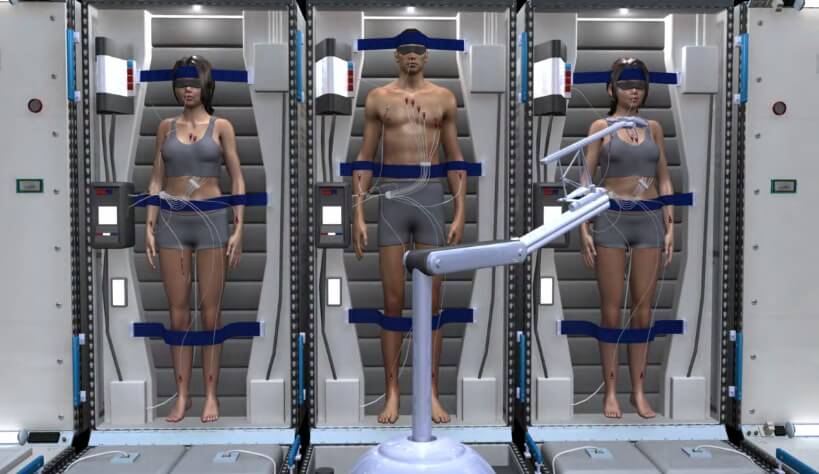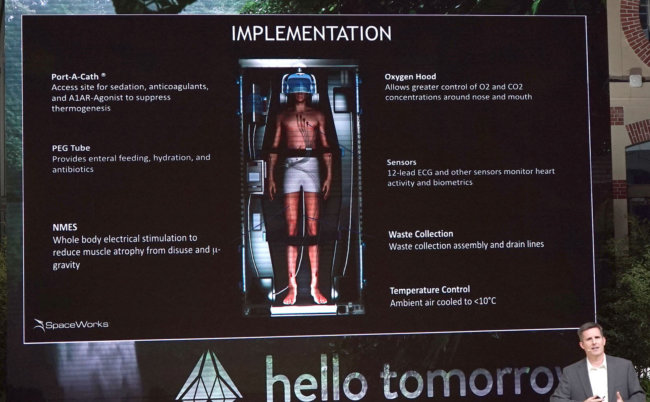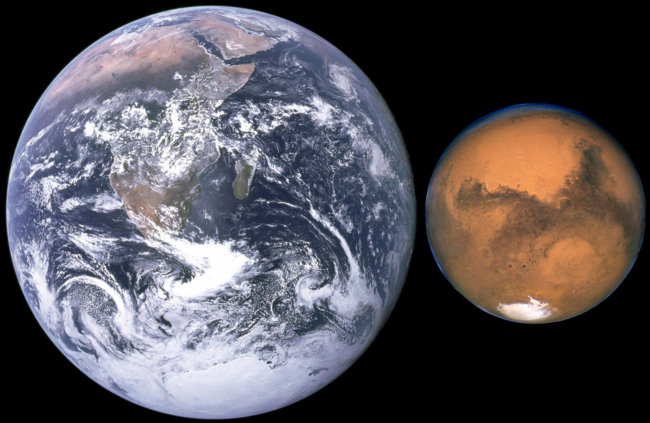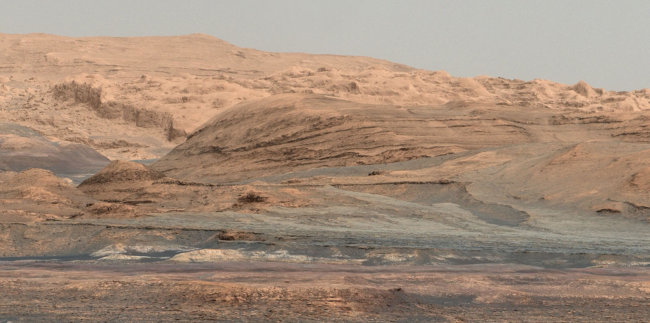
Space Agency NASA and SpaceX company is not only trying to figure out how to deliver humans to Mars, they also think about how the 200-day journey and in fact life itself on the red planet can affect the human body and what to do with it. Apparently, people are expecting all the “charms” of a long-term stay in space conditions: muscle atrophy, loss of bone density, increased intracranial pressure or other physiological problems. Coupled with the lack of resources and long-term effects of cosmic radiation, the ride promises to be very exciting and interesting.
To solve NASA and partners agencies have been working on a system that will put people in a state of complete inactivity, which essentially will be the same hibernation, which we show in science fiction movies. In addition, they are developing protective methods and tools that allow people to survive on Mars. Journalists portal Engadget caught at a scientific Symposium Hello Tomorrow, held recently in Paris, Laura Kerber of NASA, and John Bradford, Spaceworks head of the company involved in the development of space technology, and found out the details.
“We are facing a lot of difficulties, not allowing the now to get to Mars in a healthy condition,” said Bradford in his speech at the event.
Being an expert in matters of human space research, Bradford is developing a method that will allow you to avoid many described in the beginning of this article problems by putting the person in “a state of complete inactivity” or prolonged hypothermia. The use of this technology will not only reduce the risks associated with the health of astronauts, but also solve the many technical and engineering problems.
From a medical point of view, the technology will allow you to solve any kinds of so-called psychosocial disorders (being in a constant state of sleep for you, for example, will be able to avoid such condition as depression), to reduce the problem of intracranial pressure and the use of other methods, for example electro-stimulation to minimize muscle atrophy, loss of bone density and potentially have a positive impact on addressing the impact of space radiation on the body.
From a technical point of view the use of technology the introduction of the organism into a state of complete inactivity will significantly simplify the task of NASA and SpaceX for the delivery people to Mars. First, it will significantly reduce the need for food, and will also reduce the amount of living space inside the spacecraft and hence the level of energy needed to power it.
“All these things add extra load space unit. The necessary propulsive energy performs the exponential function (function of mass), so any reduction in mass will give us significant advantages,” said Bradford.
The phrase “complete inactivity of the body” may sound scary. But this thing really works. Normal human body temperature is usually in the area of 36.6 degrees Celsius, but the people who are in a state of inactivity of the body, when using the method of therapeutic hypothermia, the temperature of the body, as a rule, is at the level of 32-34 degrees Celsius. This method is often used to reduce the risk of ischemic tissue damage, for example, was used on the champion “Formulas-1” Michael Schumacher to reduce inflammation of the injured brain.
Unlike the medical hypothermia, which usually lasts for just a few days, the astronauts planned to put in a state of complete inactivity of the body for a period of two weeks, then to Wake them up for a couple of days so they can celebrate all their needs, and then to repeat the process. And so until then, until they get to Mars. It may carry certain risks. Long-term sedation (people all the time as a “vegetable”), the question of nutrition, hydration, waste disposal and proper climate control are just a few of the problems that have to be solved before using this method.
To resolve the issue, Spaceworks and NASA want to refer to the combination of three different approaches: medical, physiological and pharmaceutical. First, there is the option of taking special medicines that will make the body think that the temperature of 32-34 degrees Celsius is “normal”. And secondly, there is the option of using the method of CHEG (percutaneous endoscopic gastrostomy). This is when your stomach is directly connected tube, through which it is served food. Sounds extremely radical, but, according to experts, such an approach will significantly simplify the transition of the organism from total inactivity to awakening.

It also covers methods of electrical stimulation of the whole body to reduce muscle atrophy, the use of respiratory support (to keep the proper balance of oxygen and carbon dioxide), sensors for monitoring vital signs, computer controlled temperature environment and, of course, the system of waste removal of the body. As you can see in the picture above, the whole system will largely resemble hibernation chamber, which we used to see in various science fiction films.
The use of such a system (scientists hope) we will get a fully healthy and happy astronauts, as well as more compact and at the same time, more efficient spacecraft. In this case Mars space transport can be reduced in size almost by half, reducing its weight from 45.5 to 25.5 tons and also reducing almost by half the amount of required living space inside the ship and thus reducing by a quarter the power consumption of it systems. Shipping thousands of people to create a full Martian colony will be a real prospect.
“I believe that such an approach would open the opportunity for space travel to Mars and other destinations. Without using truly advanced technologies (like the one we offer), you have just won’t work,” says Bradford.
Maybe in this case you will arrive on Mars happy and healthy, but your real problems will begin.
“One of the most difficult problems which will have to face is an environment of high pressure, requiring you to use awkward, tight space suit, and extremely low night time temperatures,” says planetary geologist at NASA/JPL Laura Kerber.
To address this question, NASA experts are developing lighter space suits, with support for lower internal pressure, due to the compensation of mechanical compression on the body.
Cosmic radiation is also a big problem, since Mars, unlike Earth, does not have a protective magnetic field. Gravity is only 1/3 of earth’s, and scientists still are not sure how it will affect the settlers. Researchers also need to learn more about Martian dust — how dangerous its impact on the respiratory system and skin.

In addition to environmental problems, there are geographical. Mars has large reserves of land, however, the topological picture here is pretty rough.
“The length of the canyon system Valles Marineris are equivalent to US sizes. Moving here on your Rover, you can come up with the idea to avoid this place because the depth of the canyon three times more of the Grand Canyon. Forget immediately. To drive around then you can’t do it.”
Landslides, impact craters (appearing here more often than on the Ground), geysers of carbon dioxide, dust storms on the entire surface of the planet and much more – in addition, you will have to deal with it. Another problem is resources.
“The main snag is that most of the water inventory of Mars is concentrated there, where life is simply impossible,” says Kerber.
“A lot of water at the poles of the planet where it is very cold. But if you come down closer to the equator is much warmer and much easier to reach orbit. However there is no water. Exactly. Well, or almost,” adds the scientist.
Even if the astronauts will be able to find water, they will face a choice – to use it as a drinking source or as a source of production of hydrogen and oxygen for rocket fuel.
In life on Mars there is a positive side, joking Kerber. You will immediately lose two thirds of its weight, you will have 40 minutes more time each day and you will be younger than the earth, since a year lasts almost twice as long.
To study the radiation level of the atmosphere and Geology of the red planet NASA uses Rovers, but this place still remains a lot of unresolved issues. To gather more information and check the same values in different parts of the planet will require new missions. Kerber notes that the existence of a new orbital spacecraft with higher resolution cameras to search for valuable mineral resources that could be useful for survival on the planet, would bring huge benefits.

Region Bagnold Dunes at mount sharp
So where on Mars is the most suitable place for life? According to the same Kerber, she liked the region near the equator. There are a variety of fine-grained materials that can be used for laying roads. The presence of rocks in this location opens the opportunity to drill in their caves to be used as dwellings.
“Living on Mars, you will be on the cutting edge of technology, that is, you will be equipped with the most advanced existing technology. However, this life is more likely to be similar to primitive existence,” says Kerber.
“I imagine it as a time in our history when all men lived in caves. In our case, being in the cave, you will be protected from cosmic rays and sudden temperature changes. Coming closer to the exit, you’ll find a fantastic picture of the surrounding world and the flow of fresh cosmic radiation. Every day.”
In General, first during the flight to the red planet a person would have to be in a state of hypothermic coma, more like a vegetable stuck in his numerous wires, and on arrival to get into the cave and count the days until the death of his miserable existence. A great prospects! Who the hell actually decides that? Certainly not a man, just wants to be younger and to have more free time as before said Kerber.
This will only fit these desperate daredevils, as those (and equally of both sexes) who in the early 1900s were looking for the Anglo-Irish Explorer of the Antarctic sir Enrest Henry Shackleton, who wrote in the submitted to newspaper ad the following:
“In a very dangerous adventure requires people who are not afraid of small wages, bitter cold, long months of complete darkness, constant presence of danger, unlikely to return home alive, as well as fame and recognition in case of success”.
Flight and life on Mars would be akin to a trip to hell
Nikolai Khizhnyak